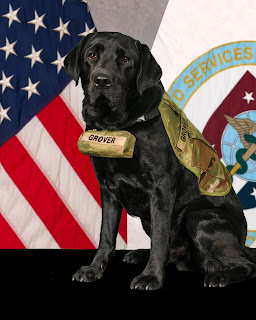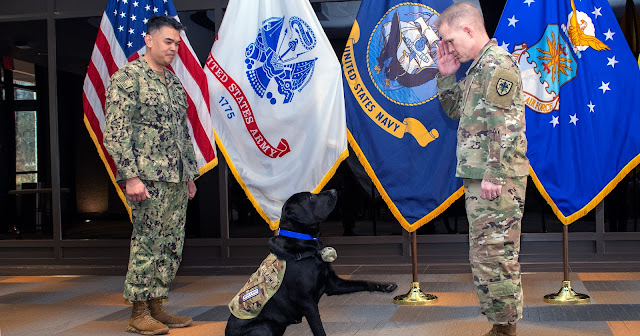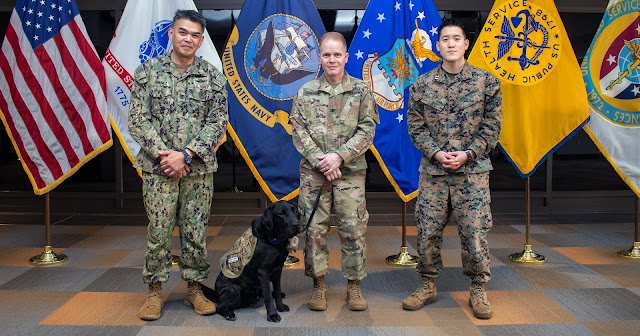Army Sgt. Grover Reports for Duty as USU's Newest Facility Dog
By Ian Neligh
The Uniformed Services University of the Health Sciences (USU) facility dog program is expanding with the addition of an enthusiastic two-year-old Labrador retriever named Grover.
Grover officially reported for duty at USU during an enlistment ceremony on campus Feb. 28, where he was made an Army sergeant and combat medic in honor of the role and contributions of enlisted personnel at the university.
 |
| USU officially enlisted Army Sgt. Grover (Sassaman), its second facility dog, on Feb 28. during a campus ceremony. (Photo credit: Tom Balfour, USU) |
The Labrador retriever comes to the university from Hero Dogs, Inc., a Maryland non-profit, which raises and trains service and facility dogs.
Grover joins the university’s current facility dog Shetland, a Golden Labrador retriever mix, who began as the school’s first facility dog in 2019. Brigade Commander Army Col. Patrick Donahue says bringing a second facility dog to the school came about because Shetland far exceeded the university’s expectations.
“We wanted to build upon his positive impact as well as our ability to continue to teach our students the valuable role these animals have in supporting individuals, and our military medical community as a whole,” Donahue says. “Not only has our facility dog program served as an enormous source of positivity and community, especially through the daily challenges of the pandemic, but it has exposed our students to the concepts of animal-assisted interventions and the many ways dogs support humans.”
Canines selected for the facility dog program must be “highly motivated” to want to be around people, display affection, have good manners, and have a host of obedience training and specialized skills for a therapeutic setting.
“The addition of Grover will allow more opportunities to further integrate the dogs into the daily experience of the students, faculty, and staff at USU,” Donahue says. “Our student handlers regularly take the dogs with them to small group classes, community events like blood drives, or even just to study in the library. Grover is going to bring some extra energy with him for sure — he has that spark in his personality that will be fun to watch.”
Although Paula Bellini, a Henry M. Jackson Foundation for the Advancement of Military Medicine
contract employee at USU, is Grover’s full-time custodian, a number of students take on the role as part-time volunteers. Army 2nd Lt. Victoria Nguyen volunteers to work as a handler for both Shetland and Grover.
“They both provide the student body a calming connection — as well as support,” Nguyen says. “I hope that people will better understand what facility dogs are and how to interact with them.”
Besides a respectable difference in rank, Nguyen says their different personalities complement one another.
“Grover is super energetic and outgoing. He reminds me more of a typical pup that you might see,” Nguyen says. “He loves people and wants to get pets from everyone. Shetland likes pets but he’s a little bit calmer — but I love their interaction. I think they bring out the best characteristics of each other. They get along really well.”
Donahue says as more military treatment facilities establish facility dog programs like the one currently in place at Walter Reed National Military Medical Center, it is increasingly likely that USU’s students will encounter these types of dogs in the course of their training and over their military careers.
“USU students will be advantaged in understanding both the value of a facility dog to a community, as well as the potential benefit of service animals to the patients they will care for,” Donahue says.
Dr. Kameha Bell, the assistant dean of the university’s Well-Being Program, says USU’s full-time facility dog program is unique among medical schools — made more so now by the inclusion of a second dog.
Bell says the school’s facility dog program is modeled after the one currently in place at Walter Reed, which provides animal-assisted therapy interventions for recovering military personnel. Similar programs are also found at other military hospitals, including Malcolm Grow Medical Clinics and Surgery Center on Joint Base Andrews in Maryland, Naval Medical Center Camp Lejeune in North Carolina, and at the Naval Medical Center in Portsmouth, Virginia.
Bell says having a second dog will allow the university to spread the focus of the program and engage more of the school’s student bodies, appointments and activities. Bell adds despite their seemingly endless energy, having two dogs will allow them a little more down time between events.
“Grover’s role should be no different to Shetland’s with regard to supporting the education of our students,” Bell says, who is Shetland’s full-time custodian.
Donahue adds that when he first assumed command at USU and met Shetland, he thought it was an amazing experience.
“I love how he meanders around the Brigade headquarters area and the student lounge,” Donahue says. “Shetland often visits me in my office. He will saunter in and come sit right next to my desk. He knows exactly what he wants — a treat. I have always kept a bag of dog biscuits in my top desk drawer for when he visits. Of course, he has to do a little work for the treat.”
Sgt. Grover will soon offer the same sort of legendary dog affection and educational opportunities for the students of USU as his superior officer, Shetland — and no doubt he will be enthusiastically vying for the same bag of dog cookies.





